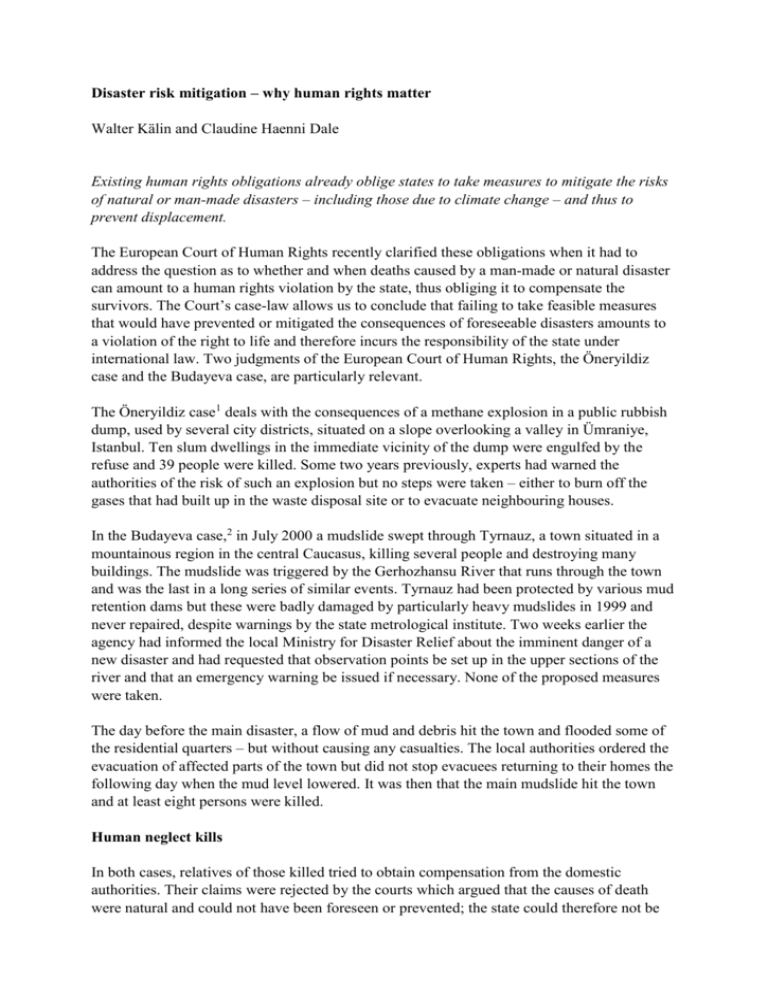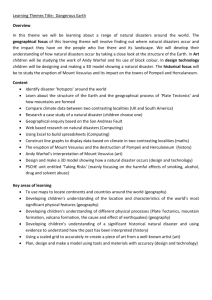Disaster risk mitigation – why human rights matter Walter Kälin and
advertisement

Disaster risk mitigation – why human rights matter Walter Kälin and Claudine Haenni Dale Existing human rights obligations already oblige states to take measures to mitigate the risks of natural or man-made disasters – including those due to climate change – and thus to prevent displacement. The European Court of Human Rights recently clarified these obligations when it had to address the question as to whether and when deaths caused by a man-made or natural disaster can amount to a human rights violation by the state, thus obliging it to compensate the survivors. The Court’s case-law allows us to conclude that failing to take feasible measures that would have prevented or mitigated the consequences of foreseeable disasters amounts to a violation of the right to life and therefore incurs the responsibility of the state under international law. Two judgments of the European Court of Human Rights, the Öneryildiz case and the Budayeva case, are particularly relevant. The Öneryildiz case1 deals with the consequences of a methane explosion in a public rubbish dump, used by several city districts, situated on a slope overlooking a valley in Ümraniye, Istanbul. Ten slum dwellings in the immediate vicinity of the dump were engulfed by the refuse and 39 people were killed. Some two years previously, experts had warned the authorities of the risk of such an explosion but no steps were taken – either to burn off the gases that had built up in the waste disposal site or to evacuate neighbouring houses. In the Budayeva case,2 in July 2000 a mudslide swept through Tyrnauz, a town situated in a mountainous region in the central Caucasus, killing several people and destroying many buildings. The mudslide was triggered by the Gerhozhansu River that runs through the town and was the last in a long series of similar events. Tyrnauz had been protected by various mud retention dams but these were badly damaged by particularly heavy mudslides in 1999 and never repaired, despite warnings by the state metrological institute. Two weeks earlier the agency had informed the local Ministry for Disaster Relief about the imminent danger of a new disaster and had requested that observation points be set up in the upper sections of the river and that an emergency warning be issued if necessary. None of the proposed measures were taken. The day before the main disaster, a flow of mud and debris hit the town and flooded some of the residential quarters – but without causing any casualties. The local authorities ordered the evacuation of affected parts of the town but did not stop evacuees returning to their homes the following day when the mud level lowered. It was then that the main mudslide hit the town and at least eight persons were killed. Human neglect kills In both cases, relatives of those killed tried to obtain compensation from the domestic authorities. Their claims were rejected by the courts which argued that the causes of death were natural and could not have been foreseen or prevented; the state could therefore not be held responsible. The relatives then appealed to the European Court of Human Rights which found that both countries were in violation of their duty to protect life, having failed to take preventive measures, and ordered them to pay substantial compensation. The Court based its findings on the recognition of a duty to protect life against the consequences of disasters by reaffirming that the right to life “does not solely concern deaths resulting from the use of force by agents of the State but also […] lays down a positive obligation on States to take appropriate steps to safeguard the lives of those within their jurisdiction” and stressing that “[t]his positive obligation entails above all a primary duty on the State to put in place a legislative and administrative framework designed to provide effective deterrence against threats to the right to life”3 While the Court in the Öneryilziz case recognised such a duty in the context of risks created by industrial and other “dangerous activities”, it expanded this approach to cover natural disasters in the Budayeva case. In implementing this obligation to protect, states have considerable flexibility with regard to the operational choices which they must make in terms of priorities and resources. However, the Court made it clear that a state becomes liable for deaths if they have occurred because the authorities neglected their duty to take preventive measures when a natural hazard had been clearly identifiable and effective means to mitigate the risk were available to them. In the Öneryildiz case, Turkey had breached this obligation because the municipal authorities, though aware of the danger, had failed to take the necessary safety measures and had permitted dwellings to be built in the danger zone. In the Budayeva case, a causal link was found between serious administrative flaws that impeded the implementation of necessary measures and the deaths of the victims. Conclusion Other covenants and conventions contain the same obligation to protect life and the approach taken by the European Court of Human Right is likely to be followed in other jurisdictions in similar cases. In summary, the individual right to life and the corresponding state obligation to protect life require that, with regard to natural disasters, including those caused by climate change, relevant the authorities must: enact and implement laws dealing with all relevant aspects of disaster risk mitigation and set up the necessary mechanisms and procedures take the necessary administrative measures, including supervising potentially dangerous situations inform the population about possible dangers and risks evacuate potentially affected populations conduct criminal investigations and prosecute those responsible for having neglected their duties in case of deaths caused by a disaster compensate surviving relatives of victims killed as a consequence of neglecting these duties. These human rights standards are of great practical import as they empower actual and potential victims of natural disasters to demand that authorities take the necessary measures to prevent deaths. For humanitarian agencies they highlight the relevance of a rights-based approach to disaster management. Walter Kälin (walter.kaelin@oefre.unibe.ch) is the Representative of the UN SecretaryGeneral on the Rights of IDPs. Claudine Haenni Dale (rsg.idps@gmail.com)is focal point on natural disasters of the IASC Protection Cluster Working Group. 1 European Court of Human Rights, Öneryildiz v. Turkey, Application 48939/99, judgment of 30 November 2004. 2 European Court of Human Rights, Budayeva and others v. Russia, Applications nos. 15339/02, 21166/02, 20058/02, 11673/02 and 15343/02, judgment of 20 March 2008. 3 Budayeva case, §§ 128-129






